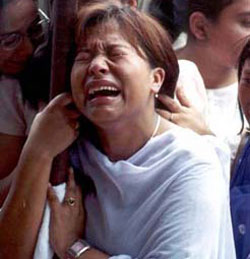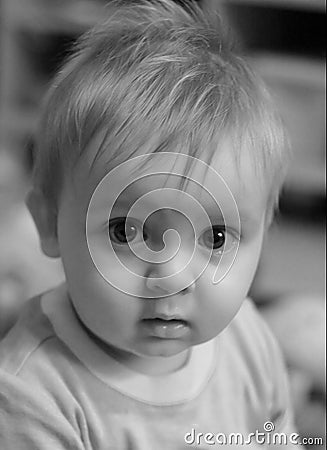Although crying is an infant's mode of communication, it is not limited to a monotonous sound. There are three different types of cries apparent in infants. The first of these three is a basic cry, which is a systematic cry with a pattern of crying and silence. The basic cry starts with a cry coupled with a briefer silence, which is followed by a short high-pitched inspiratory whistle. Then, there is a brief silence followed by another cry. Hunger is a main stimulant of the basic cry. An anger cry is much like the basic cry; however, in this cry, more excess air is forced through the vocal cords, making it a louder, more abrupt cry. This type of cries is characterized by the same temporal sequence as the basic pattern but distinguished by differences in the length of the various phase components. The third cry is the pain cry, which, unlike the other two, has no preliminary moaning. The pain cry is one loud cry, followed by a period of breath holding. Most adults can determine whether an infant's cries signify anger or pain. Most parents also have a better ability to distinguish their own infant's cries than those of a different child. A 2009 study found that babies mimic their parents' pitch contour. French infants wail on a rising note while the Germans favor a falling melody.
There have been many attempts to differentiate between the two distinct types of crying (one negative and one positive). Different perspectives have been broken down into three dimensions to examine the emotions being felt and also to grasp the contrast between the two types.
Tears produced during emotional crying have a chemical composition which differs from other types of tears. They contain significantly greater quantities of the hormones prolactin, adrenocorticotropic hormone, Leu-enkephalin and the elements potassium and manganese.
William H. Frey II, a biochemist at the University of Minnesota, proposed that people feel "better" after crying, due to the elimination of hormones associated with stress, specifically adrenocorticotropic hormone. This, paired with increased mucosal secretion during crying, could lead to a theory that crying is a mechanism developed in humans to dispose of this stress hormone when levels grow too high.
A neuronal connection between the lacrimal gland (tear duct) and the areas of the human brain involved with emotion has been established. Some scientists believe that only humans produce tears in response to emotional states while others disagree. Charles Darwin wrote in The Expression of the Emotions in Man and Animals that the keepers of Indian elephants in the London Zoo told him that their charges shed tears in sorrow.
Friday, October 28, 2011
Free Christian Wallpaper
Also significant was the advent of soul music as a major commercial force. Developing out of rhythm and blues with a re-injection of gospel music and pop, led by pioneers like Ray Charles and Sam Cooke from the mid-1950s, by the early '60s figures like Marvin Gaye, James Brown, Aretha Franklin, Curtis Mayfield and Stevie Wonder were dominating the R&B charts and breaking through into the main pop charts, helping to accelerate their desegregation, while Motown and Stax/Volt Records were becoming major forces in the record industry. All of these elements, including the close harmonies of doo wop and girl groups, the carefully crafted song-writing of the Brill Building Sound and the polished production values of soul, have been seen as influencing the Merseybeat sound, particularly the early work of The Beatles, and through them the form of later rock music. Some historians of music have also pointed to important and innovative technical developments that built on rock and roll in this period, including the electronic treatment of sound by such innovators as Joe Meek, and the elaborate production methods of the Wall of Sound pursued by Phil Spector.
In the 1980s the terms indie rock and alternative rock were used interchangeably. By the mid-1990s, as elements of the movement began to attract mainstream interest, particularly grunge and then Britpop, post-grunge and pop-punk, the term alternative began to lose its meaning. Those bands following the less commercial contours of the scene were increasingly referred to by the label indie. They characteristically attempted to retain control of their careers by releasing albums on their own or small independent labels, while relying on touring, word-of-mouth, and airplay on independent or college radio stations for promotion. Linked by an ethos more than a musical approach, the indie rock movement encompassed a wide range of styles, from hard-edged, grunge-influenced bands like The Cranberries and Superchunk, through do-it-yourself experimental bands like Pavement, to punk-folk singers such as Ani DiFranco. It has been noted that indie rock has a relatively high proportion of female artists compared with preceding rock genres, a tendency exemplified by the development of feminist-informed Riot Grrrl music. Many countries have developed an extensive local indie scene, flourishing with bands with enough popularity to survive inside the respective country, but virtually unknown outside them.
Psychedelic music's LSD-inspired vibe began in the folk scene, with the New York-based Holy Modal Rounders using the term in their 1964 recording of "Hesitation Blues". The first group to advertise themselves as psychedelic rock were the 13th Floor Elevators from Texas, at the end of 1965; producing an album that made their direction clear, with The Psychedelic Sounds of the 13th Floor Elevators the following year. The Beatles introduced many of the major elements of the psychedelic sound to audiences in this period, with "I Feel Fine" using guitar feedback; in late 1965 the Rubber Soul album included the use of a sitar on "Norwegian Wood" and they employed backmasking on their 1966 single B-side "Rain" and other tracks that appeared on their Revolver album later that year.
By the late 1960s a number of distinct rock music sub-genres had emerged, including hybrids like blues rock, folk rock, country rock, and jazz-rock fusion, many of which contributed to the development of psychedelic rock influenced by the counter-cultural psychedelic scene. New genres that emerged from this scene included progressive rock, which extended the artistic elements; glam rock, which highlighted showmanship and visual style, and the diverse and enduring major sub-genre of heavy metal, which emphasized volume, power and speed. In the second half of the 1970s, punk rock both intensified and reacted against some of these trends to produce a raw, energetic form of music characterized by overt political and social critiques. Punk was an influence into the 1980s on the subsequent development of other sub-genres, including New Wave, post-punk and eventually the alternative rock movement. From the 1990s alternative rock began to dominate rock music and break through into the mainstream in the form of grunge, Britpop, and indie rock. Further fusion sub-genres have since emerged, including pop punk, rap rock, and rap metal, as well as conscious attempts to revisit rock's history, including the garage rock/post-punk revival at the beginning of the new millennium.
The worldwide popularity of rock music meant that it became a major influence on culture, fashion and social attitudes. Different sub-genres of rock were adopted by, and became central to, the identity of a large number of sub-cultures. In the 1950s and 1960s, respectively, British youths adopted the Teddy Boy and Rockers subcultures, which revolved around US rock and roll. The counter-culture of the 1960s was closely associated with psychedelic rock. The mid-1970s punk subculture began in the US, but it was given a distinctive look by British designer Vivian Westwood, a look which spread worldwide. Out of the punk scene, the Goth and Emo subcultures grew, both of which presented distinctive visual styles.
In the 1980s the terms indie rock and alternative rock were used interchangeably. By the mid-1990s, as elements of the movement began to attract mainstream interest, particularly grunge and then Britpop, post-grunge and pop-punk, the term alternative began to lose its meaning. Those bands following the less commercial contours of the scene were increasingly referred to by the label indie. They characteristically attempted to retain control of their careers by releasing albums on their own or small independent labels, while relying on touring, word-of-mouth, and airplay on independent or college radio stations for promotion. Linked by an ethos more than a musical approach, the indie rock movement encompassed a wide range of styles, from hard-edged, grunge-influenced bands like The Cranberries and Superchunk, through do-it-yourself experimental bands like Pavement, to punk-folk singers such as Ani DiFranco. It has been noted that indie rock has a relatively high proportion of female artists compared with preceding rock genres, a tendency exemplified by the development of feminist-informed Riot Grrrl music. Many countries have developed an extensive local indie scene, flourishing with bands with enough popularity to survive inside the respective country, but virtually unknown outside them.
Psychedelic music's LSD-inspired vibe began in the folk scene, with the New York-based Holy Modal Rounders using the term in their 1964 recording of "Hesitation Blues". The first group to advertise themselves as psychedelic rock were the 13th Floor Elevators from Texas, at the end of 1965; producing an album that made their direction clear, with The Psychedelic Sounds of the 13th Floor Elevators the following year. The Beatles introduced many of the major elements of the psychedelic sound to audiences in this period, with "I Feel Fine" using guitar feedback; in late 1965 the Rubber Soul album included the use of a sitar on "Norwegian Wood" and they employed backmasking on their 1966 single B-side "Rain" and other tracks that appeared on their Revolver album later that year.
By the late 1960s a number of distinct rock music sub-genres had emerged, including hybrids like blues rock, folk rock, country rock, and jazz-rock fusion, many of which contributed to the development of psychedelic rock influenced by the counter-cultural psychedelic scene. New genres that emerged from this scene included progressive rock, which extended the artistic elements; glam rock, which highlighted showmanship and visual style, and the diverse and enduring major sub-genre of heavy metal, which emphasized volume, power and speed. In the second half of the 1970s, punk rock both intensified and reacted against some of these trends to produce a raw, energetic form of music characterized by overt political and social critiques. Punk was an influence into the 1980s on the subsequent development of other sub-genres, including New Wave, post-punk and eventually the alternative rock movement. From the 1990s alternative rock began to dominate rock music and break through into the mainstream in the form of grunge, Britpop, and indie rock. Further fusion sub-genres have since emerged, including pop punk, rap rock, and rap metal, as well as conscious attempts to revisit rock's history, including the garage rock/post-punk revival at the beginning of the new millennium.
The worldwide popularity of rock music meant that it became a major influence on culture, fashion and social attitudes. Different sub-genres of rock were adopted by, and became central to, the identity of a large number of sub-cultures. In the 1950s and 1960s, respectively, British youths adopted the Teddy Boy and Rockers subcultures, which revolved around US rock and roll. The counter-culture of the 1960s was closely associated with psychedelic rock. The mid-1970s punk subculture began in the US, but it was given a distinctive look by British designer Vivian Westwood, a look which spread worldwide. Out of the punk scene, the Goth and Emo subcultures grew, both of which presented distinctive visual styles.
Baby Poems 3
Subscribe to:
Posts (Atom)














































